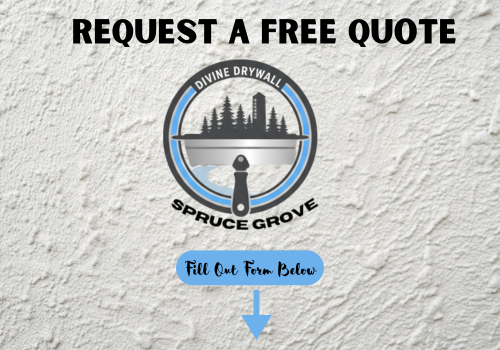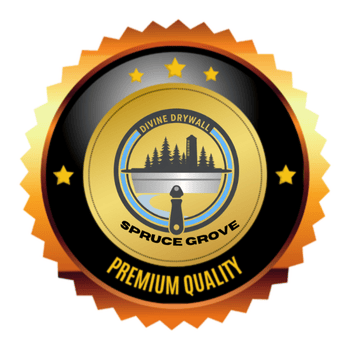Texture Repair & Reblend in Spruce Grove, AB
Divine Drywall Spruce Grove provides expert texture repair and reblending for homes and businesses across Spruce Grove, AB. From subtle orange peel to heavy knockdown, our team restores damaged or uneven surfaces so repairs disappear back into the original finish.
Texture issues can happen after patchwork, water damage, or everyday wear. We use the right mix of materials and trade-tested methods—mesh tape, setting compound, texture hoppers, and feathering techniques—to rebuild the surface and dial in a perfect match. With an eye for pattern, depth, and sheen, our repair techs ensure your walls and ceilings look consistent from every angle.
If you’re ready for clean, uniform results, call 587-415-5093. You can also learn more about our offerings on our
drywall repair services page.

Divine Drywall Spruce Grove (SP)

Expert Texture Repair and Reblend Services in Spruce Grove
Professional texture repair requires precise matching techniques and specialized blending methods to achieve seamless results. Contractors must understand different texture types and application methods to properly restore damaged surfaces.
Texture Matching Techniques
Visual Assessment forms the foundation of successful texture matching. You need contractors who can identify specific texture patterns like knockdown, orange peel, or acoustic finishes through careful examination.
Sample Testing ensures accurate color and pattern reproduction. Professional contractors create small test patches in inconspicuous areas to match existing textures before proceeding with full repairs.
Material Selection directly impacts blend quality. The right primer, paint, and texturing compounds must match the original application for proper adhesion and appearance.
Texture Type Matching Method Tools Required
Orange Peel Spray application Hopper gun, compressor
Knockdown Roll and knock Texture roller, knife
Acoustic Spray texture Specialized hopper
Lighting Conditions affect texture appearance throughout the day. Experienced contractors evaluate repairs under different lighting to ensure consistent visual integration.
Ceiling Texture Repair Solutions
Patch Preparation requires complete removal of damaged material and proper surface cleaning. You want contractors who prepare the substrate correctly to prevent future adhesion problems.
Blend-Back Finishing extends repair areas beyond visible damage boundaries. This technique creates gradual transitions that eliminate obvious repair lines.
Moisture Protection prevents recurring damage in areas prone to leaks or condensation. Professional contractors address underlying causes before applying new texture.
Acoustic Texture Repair demands specialized equipment and techniques. Popcorn and similar textures require specific application methods to match existing patterns and density.
Wall Texture Repair Services
Surface Prep includes sanding, cleaning, and priming damaged areas. Proper preparation ensures new texture adheres correctly and blends seamlessly with existing surfaces.
Patch and Texture services address holes, cracks, and damaged sections. Contractors must match both the base repair and texture application to surrounding areas.
Texture Touch-ups handle minor damage and wear spots. Small repairs require careful attention to avoid over-texturing or creating noticeable patches.
Color Integration ensures repaired areas match existing paint colors and sheen levels. Professional contractors use color-matching tools and techniques for accurate results.
Specialized Texture Finishes and Blending
Professional texture repair requires specialized techniques for different surface types, with specific methods for knockdown, orange peel, and acoustic textures. Skilled contractors use precise blending applications to create seamless repairs that match existing wall and ceiling patterns.
Knockdown Texture Repair Methods
Knockdown texture repair involves applying joint compound in a stippled pattern and then lightly flattening the peaks with a knockdown knife. The timing of the knockdown process determines the final texture appearance.
You need proper surface preparation before applying the base coat. Clean the damaged area and apply primer to ensure proper adhesion of the new texture material.
Key Steps for Knockdown Repair:
- Apply base compound with a hopper gun or brush
- Wait 10-15 minutes for partial drying
- Lightly drag knockdown knife across surface
- Feather edges into existing texture
The moisture content affects how well the texture blends. Contractors adjust drying time based on humidity levels and room temperature to achieve consistent results.
Orange Peel Repair Applications
Orange peel texture creates a subtle dimpled surface that resembles citrus fruit skin. This texture requires specific spray gun settings and compound consistency for proper application.
You achieve orange peel texture through controlled spray patterns and air pressure settings. The compound mixture should have a consistency similar to thick paint for optimal results.
Orange Peel Application Variables:
Factor Setting
Air Pressure 25-40 PSI
Nozzle Size 4-6mm
Spray Distance 18-24 inches
The repair area must blend smoothly with surrounding texture. Contractors practice spray patterns on test surfaces before applying to actual repair areas.
Multiple light coats work better than single heavy applications. This prevents drips and creates more uniform texture patterns that match existing surfaces.
Acoustic Texture Restoration
Acoustic texture contains vermiculite or other sound-dampening materials that create a popcorn-like appearance. These textures require specialized removal and application techniques.
You must test older acoustic textures for asbestos before beginning repair work. Professional contractors follow safety protocols when working with potentially hazardous materials.
Acoustic Texture Repair Process:
- Contain work area with plastic sheeting
- Remove damaged texture with scraping tools
- Apply bonding primer to bare surfaces
- Spray new acoustic texture material
- Allow proper curing time
The texture material comes pre-mixed or requires specific ratios of water and additives. Contractors use specialized spray equipment designed for thicker acoustic compounds.
Matching existing acoustic texture involves adjusting material consistency and spray pressure. The goal is creating uniform coverage that blends seamlessly with surrounding areas.
Blend-Back Finishing Options
Blend-back finishing creates invisible transitions between new and existing textures through gradual feathering techniques. This method prevents visible repair lines or pattern changes.
You extend the texture application beyond the immediate repair area to create smooth transitions. The blending zone typically extends 12-18 inches from the actual damage.
Blend-Back Techniques:
- Wet Blending: Working texture while still moist
- Dry Blending: Sanding and reshaping after drying
- Multi-Stage Blending: Layering multiple texture applications
Contractors use different tools for blending depending on texture type. Sponges work well for stippled textures while brushes suit swirl patterns.
The final step involves matching paint sheen and color across the blended area. This ensures the repair remains invisible under various lighting conditions.
Surface Preparation, Patch and Texture, and Touch-Ups
Proper surface preparation forms the foundation for successful texture matching, while effective patching techniques ensure seamless integration with existing finishes. Touch-up work requires precision and the right materials to achieve consistent results across the entire surface.
Surface Prep Essentials
Clean surfaces are critical for texture adhesion and long-lasting repairs. Remove all loose paint, dust, and debris from the repair area using a damp cloth or vacuum.
Sand rough edges around damaged areas with 120-grit sandpaper to create smooth transitions. This prevents visible lines where new texture meets existing surfaces.
Key preparation steps:
- Apply primer to bare drywall or patched areas
- Allow 24 hours drying time before texturing
- Mask surrounding surfaces with plastic sheeting
- Ensure room temperature stays between 65-75°F
Prime all repair areas with high-quality wall primer. Unprimed surfaces absorb texture materials differently than painted walls, creating noticeable color and sheen variations.
Check for loose or damaged texture around the repair zone. Scrape away any flaking material to establish solid boundaries for your new texture application.
Patch and Texture Integration
Apply drywall patches using pre-mixed compound for small holes or mesh patches for larger damage. Sand dried compound smooth and level with the surrounding wall surface.
Thin your texture material to match the existing consistency. Mix small test batches first to determine the correct water-to-compound ratio for your specific texture type.
Texture application techniques:
- Knockdown texture: Apply with hopper gun, flatten with plastic knife
- Orange peel: Use spray bottle or texture roller for fine stipple effect
- Acoustic texture: Mix with appropriate aggregate, spray in overlapping passes
Work from the patch center outward to blend edges naturally. Apply texture in thin, even coats rather than attempting to match thickness in a single application.
Allow each coat to dry completely before adding additional layers. Rush jobs create uneven surfaces that become more obvious once painted.
Texture Touch-Ups for Consistency
Use texture touch-up sprayer kits for small repair areas. These kits include the sprayer, knockdown tool, and pre-mixed materials needed for most common textures.
Touch-up materials needed:
- Spray texture in matching type
- Knockdown blade or sponge
- Drop cloths and masking tape
- Fine-mist spray bottle
Practice your technique on cardboard before applying to walls. Each texture type requires specific timing and tool pressure to achieve proper results.
Blend touch-ups into surrounding areas by feathering edges. Apply texture slightly beyond the damaged area, then use appropriate tools to knock down or smooth transitions.
Professional contractors often thin standard texture compounds with water to create custom consistencies. This allows precise matching of existing wall finishes that may have aged or settled over time.
